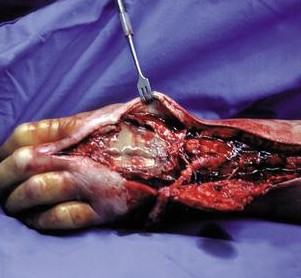Read our main article on necrotizing fasciitis, also known as flesh-eating bacteria and flesh-eating disease
Media reports have popularized the term "flesh-eating bacteria" to refer to a type of very rare but serious bacterial infection known as necrotizing fasciitis. Necrotizing fasciitis is an infection that starts in the tissues just below the skin and spreads along the flat layers of tissue (known as fascia) that separate different layers of soft tissue, such as muscle and fat. This dangerous infection is most common in the arms, legs, and abdominal wall and is fatal in 30%-40% of cases.
Although necrotizing fasciitis may be caused by an infection with one or more than one bacterium, in most cases the term flesh-eating bacteria has been applied to describe infections caused by the bacterium known asStreptococcus pyogenes. The term flesh-eating has been used because the bacterial infection produces toxins that destroy tissues such as muscles, skin, and fat. Streptococcus pyogenes is a member of the group A streptococci, a group of bacteria that are commonly responsible for mild cases of sore throat (pharyngitis) and skin infections, as well as rare, severe illnesses such as toxic shock syndrome and necrotizing fasciitis. Most infections with group A streptococci result in mild illness and may not even produce symptoms.
Sometimes, other bacteria or even a combination of different bacteria may produce necrotizing fasciitis. A case was reported in 2012 of a young woman who suffered a zip-lining accident on a river in West Georgia. She contracted an infection with the bacteria Aeromonas hydrophila, which produced a necrotizing infection that resulted in the loss of a leg and part of her abdomen.
The symptoms of necrotizing fasciitis include redness, swelling, and pain in the affected area. Blisters may be seen in the involved area of skin. Fever,nausea, vomiting, and other flulike symptoms are common. Another characteristic of necrotizing fasciitis is that the symptoms develop very rapidly, usually within 24 hours after a wound in the skin has allowed the bacteria to invade the tissues beneath the skin. The pain is described as being more severe than would be expected from the appearance of the wound. Late symptoms can include death (gangrene) of affected areas with scaling, discoloration, or peeling of the skin.
Many of the people who have developed necrotizing fasciitis have been in good health before developing the condition. People with chronic medical conditions (for example diabetes and cancer) or who have weakened immune systems are at an increased risk of developing necrotizing fasciitis. Recent wounds (including surgical incisions) and recent viral infections that cause a rash (such as chickenpox) also confer an increased risk.
Necrotizing fasciitis is treated with antibiotics, and early treatment is critical. Hospitalization, usually with treatment in the intensive-care unit (ICU), is required. Surgery to remove infected fluids and tissue may be necessary, along with medications to treat shock and other potential complications.
REFERENCE:
Schwartz, Robert A. "Dermatologic Manifestations of Necrotizing Fasciitis." Medscape.com. June 9, 2011. <http://emedicine.medscape.com/article/1054438-overview>.
Schwartz, Robert A. "Dermatologic Manifestations of Necrotizing Fasciitis." Medscape.com. June 9, 2011. <http://emedicine.medscape.com/article/1054438-overview>.
